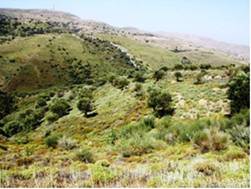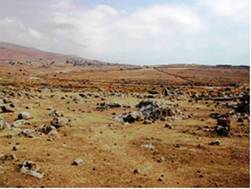Land abandonment
Land abandonment is related to decreasing land profitability, usually resulting in change land use from agriculture to grazing land. The extensive deforestation and intensive cultivation of hilly areas especially during the last decades has led to soil erosion and the formation of shallow skeletal soils. As the soil is eroded, land use is usually shifted from agriculture to pasture due to increasingly poor yields from the various agricultural crops. Such a pasture land in the Mediterranean region is defined as an abandoned land today. Various authors have simultaneously used the terms 'abandoned land' and 'grazing land', but grazing or hunting an abandoned land is considered a traditional use in the Mediterranean region. Land abandonment does not necessarily mean that land is no longer used, either by agriculture or any other rural economic activity. It means a change in land use from the traditional or recent pattern to another, less intensive pattern.
Land abandonment may have positive or negative impacts on desertification depending on the soils and climatic conditions of the area. Soils under favourable climatic conditions that sustain plant cover may improve with time by accumulating organic materials, increasing floral and faunal activity, improving soil structure, increasing infiltration capacity, and therefore decrease erosion potential and desertification risk (Fig. 80). On the contrary, areas with soils relatively shallow, of low organic matter content, with thin and of low resilience capacity vegetation cover, in steep slopes, with adverse climatic conditions, and overgrazed result in negative impacts of land abandonment (Fig. 80). The natural restoration processes in these areas are really slow, almost impossible, and persistent erosion processes can lead to severe soil degradation and desertification.


Fig. 80. Examples of areas with positive (left) and negative (right) effects of land abandonment
Data on land abandonment have been obtained from the National Statistical Services of the study sites or in consultation with the local cooperatives. The analysis of ortho-photomaps or satellite data has been also used. The rate of land abandonment has been expressed in hectares of land abandoned every 10 years on 10 km2 territory. The following four classes of rate of land abandonment have been defined: (a) low-abandoned area <10 ha per 10 years per 10 km2 of territory, (b) moderate-abandoned area 10-25 ha per 10 years per 10 km2 of territory, (c) high- abandoned area 26-50 ha per 10 years per 10 km2 of territory, and (d) very high-abandoned area >50 ha per 10 years per 10 km2 of territory.
As Table 11 shows, data for this indicator have been collected in 1141 study field sites, corresponding to 14 study sites. As Fig. 81 shows, in the majority of the study field sites the rate of abandonment of the land in the around territory was low (<10 ha per 10 years per 10 km2), covering 63.8% of the study sites. This rate of land abandonment has been identified in all cases of the study sites of Santiago Island-Cape Verde, Mamora Sehoul-Morocco, Cointzio Catchment-Mexico, and Crete-Greece, and is some cases in the study sites of Boteti Area-Botswana, Novij Saratov-Russia, Djanybek-Russia, Zeuss Koutine-Tunisia, Gois-Portugal, and Mação- Portugal. Moderate rate of land abandonment (10-25 ha per 10 years per 10 km2) has been defined in 18.2% of the study field sites, corresponding to all cases of the study sites of Eskisehir-Turkey, Konya Karapinar plain-Turkey, and in few cases in Boteti Area-Botswana, Gois-Portugal, and Novij Saratov-Russia. High rate of land abandonment (26-50 ha per 10 years per 10 km2) has been identified in 15.1% of the study field sites, corresponding to the study sites of Novij Saratov-Russia, Djanybek-Russia, and Guadalentin Basin Murcia-Spain. Very high rate of land abandonment (>50 ha per 10 years per 10 km2) has been defined in few cases of the Zeuss Koutine-Tunisia study site (Fig. 81).

Fig. 81. Distribution of rate of land abandonment classes identified in the study field sites